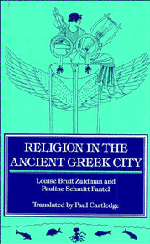Book contents
- Frontmatter
- Contents
- List of illustrations
- Author's preface to the English translation
- Translator's introduction
- List of sources
- PART I Introduction: How should we study Greek civic religion?
- PART II Cult-practices
- PART III Systems for representing the divine
- PART IV Envoi
- Appendixes
- I The classical Greek temple
- II The monuments of the Athenian Akropolis
- Bibliography
- Index
II - The monuments of the Athenian Akropolis
Published online by Cambridge University Press: 05 June 2012
- Frontmatter
- Contents
- List of illustrations
- Author's preface to the English translation
- Translator's introduction
- List of sources
- PART I Introduction: How should we study Greek civic religion?
- PART II Cult-practices
- PART III Systems for representing the divine
- PART IV Envoi
- Appendixes
- I The classical Greek temple
- II The monuments of the Athenian Akropolis
- Bibliography
- Index
Summary
THE PERIKLEAN BUILDING PROGRAMME
After about 450 the Athenians stopped fighting the Persians, and from 445 they were for over a decade at peace also with their major Greek rival, Sparta. It was during this quite exceptional pacific interlude that the great Akropolis building programme was launched. Its chief political architect was Perikles, who also served on the board of building commissioners (epistatai). The rebuilt Akropolis conveyed different messages to different groups of worshippers and other visitors. Here is how it struck one cultural pilgrim in the second century ce:
The Akropolis has a single entrance; it offers no other because the whole rock is abrupt and strongly-walled. The Propylaia has a roof of white marble, which down to my day is still without peer for the size and beauty of the stone. I cannot say for certain whether the equestrian statues represent the children of Xenophon, or were simply made for decorative effect. To the right of the Propylaia is the temple of Nikē Apteros (‘Wingless Victory’). From here you can see the sea clearly, and they say this is where Aigeus plunged to his death … To the left of the Propylaia is a building containing paintings … At the actual entrance to the Akropolis are statues of Hermes Propylaios and the Graces, said to be by Socrates son of Sophroniskos … [Pausanias now describes everything he passes on his way up to the Parthenon, including numerous statues whose legendary associations he relates.]
- Type
- Chapter
- Information
- Religion in the Ancient Greek City , pp. 242 - 246Publisher: Cambridge University PressPrint publication year: 1992



